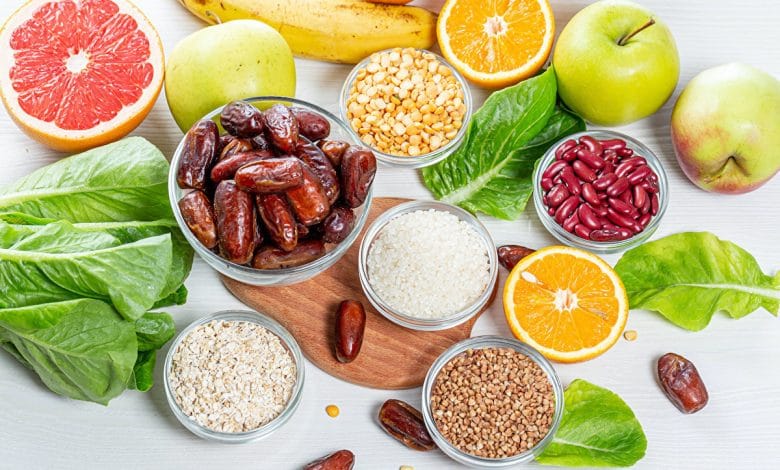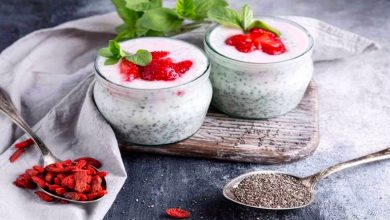High Fiber Foods: The Best Foods High In Fiber!

High Fiber Foods: Getting enough fiber in your diet is important for your digestive health, and it can help protect you against common chronic diseases.
Even though diets rich in this nutrient have been linked to a longer life, lower rates of heart disease and cancer, and reduced rates of obesity, most Americans aren’t meeting their daily fiber needs.
Fortunately, there are plenty of delicious fiber-rich foods that can help you meet your daily needs.
Here’s why fiber is important for your health, including the best sources of fiber.
Also Read: Cut Your Heart Disease Risk: 4 Nuts That Cut Your Heart Disease Risk
What Is Fiber?
Fiber is a type of indigestible nutrient that’s concentrated in plant foods.1 Unlike other nutrients, your body can’t digest or absorb fiber, so it passes through your small intestine into your large intestine mostly intact.
There are two main categories of fiber: soluble and insoluble.

Soluble Fiber
Soluble fibers dissolve in water and can be fermented or broken down by your intestinal bacteria, which releases gas as well as beneficial compounds called short-chain fatty acids (SCFAs). Sources of soluble fiber include oats, fruits, and beans. There are different categories of soluble fiber, each with different effects on health:
- Soluble, viscous/gel-forming, readily fermented fibers: These fibers thicken in water and are easily fermented by gut bacteria. Examples include beta-glucans found in oats.
- Soluble, viscous/gel-forming, non-fermented fibers: These fibers thicken in water but are resistant to fermentation. Examples include psyllium husk.
- Soluble, nonviscous, readily fermented fibers: These fibers dissolve in water but do not thicken. They are easily fermented by gut bacteria. Examples include inulin and wheat dextrin.
Insoluble Fiber
High Fiber Foods, Insoluble fiber doesn’t dissolve and is poorly fermented by gut bacteria. This type of fiber passes through your digestive system intact. Insoluble fiber is concentrated in foods like whole grains, nuts, and seeds.
Most whole foods contain a combination of insoluble and soluble fibers, but some are more concentrated in one than the other. Fiber supplements usually contain one type of fiber, such as psyllium husk, which is a type of soluble fiber.
Why Is Fiber Important?
Fiber is well-known for its positive impact on the digestive system, but it benefits health in other ways, too.
Improves Digestive Health
Both insoluble and soluble fiber help you have comfortable and regular bowel movements.
Insoluble fiber bulks up your poop and helps promote comfortable bowel movements, while soluble fiber attracts water to your stool, which helps keep it soft and easy to pass.
When soluble fiber is fermented by your gut bacteria, it produces compounds called short-chain fatty acids (SCFAs), such as butyrate, acetate, and propionate.5 SCFAs positively impact gut health in a number of ways by nourishing intestinal cells, regulating intestinal inflammation, and strengthening the gut lining.6
Diets high in fiber can also help prevent and treat digestive conditions like constipation and diverticular disease.

Decreases the Risk of Certain Health Conditions
High Fiber Foods, Following a high-fiber diet could help reduce your risk of a number of health conditions, including colon cancer, heart disease, and type 2 diabetes.
Fiber is important for regulating intestinal inflammation, promoting a healthy body weight, and reducing cholesterol levels, all of which are critical for lowering disease risk.1 Study findings suggest that people with high fiber intake may have up to a 21% reduced risk of colon cancer compared to people with low fiber intake.
High Fiber Foods, What’s more, people who eat more fiber tend to live longer than people who follow low-fiber diets.
Promotes a Healthy Body Weight
Fiber helps you feel full and satisfied after eating, which could help you maintain a healthy body weight. Soluble fiber slows down your digestion and the absorption of nutrients, which helps you feel fuller for longer.
High Fiber Foods, A 2019 study that included 345 people found that, compared to all other dietary components, fiber intake was the strongest predictor of weight loss. Diets linked to healthy body weight like the Mediterranean diet and plant-based diets are high in fiber-rich foods like beans, vegetables, fruits, and nuts.
Improves Cholesterol
Having high cholesterol levels has been associated with an increased risk of heart disease. Fortunately, following a nutritious, high-fiber diet can help promote healthy blood lipid levels and protect your heart.
High Fiber Foods, Fiber helps decrease cholesterol absorption by the body and increases its excretion. This is why following a high-fiber diet has been shown to lower blood levels of cholesterol and reduce heart disease risk.
In a 2017 umbrella review of 31 meta-analyses, all of the included studies found significant reductions in coronary heart disease, stroke, and death from heart disease when comparing the highest versus lowest dietary fiber intake.

What Foods Are High in Fiber?
There are plenty of fiber-rich foods that suit most every dietary preference.
Vegetables
- Mashed sweet potato: 8.2 grams of fiber per cup
- Artichokes: 6.84 grams per medium-sized artichoke
- Brussels sprouts: 6 grams of fiber per cup
- Collard greens: 6 grams of fiber per cup
- Broccoli: 5.14 grams of fiber per cup
Fruits
- Avocadoes: 13.5 grams of fiber per avocado
- Raspberries: 9.75 grams of fiber per cup
- Guava: 8.9 grams of fiber per cup
- Blackberries: 7.63 grams per cup
- Pear: 7.13 grams of fiber per cup
Whole Grains
- Teff: 7 grams of fiber per cup
- Barley: 5.97 grams of fiber per cup
- Quinoa: 5.18 grams of fiber per cup
- Oats: 3.98 grams of fiber per cup
- Brown rice: 3.12 grams of fiber per cup
Nuts and seeds
- Chia seeds: 9.75 grams of fiber per ounce
- Ground flax seeds: 8 grams per 30-gram serving
- Almonds: 3.5 grams per ounce
- Sunflower seeds: 3.26 grams of fiber per ounce
- Pecans: 2.72 grams of fiber per ounce
Legumes
- Navy beans: 19 grams of fiber per cup
- Lentils: 15.6 grams per ½ cup
- Black beans: 15 grams of fiber per cup
- Kidney beans: 13.1 grams of fiber per cup
- Chickpeas: 12.5 grams of fiber per cup
Other High-fiber Foods
- Cacao nibs: 8 grams of fiber per ounce
- Psyllium husk powder: 7 grams of fiber per tablespoon
- Coconut flakes: 6 grams of fiber per half cup
- 80% dark chocolate: 3.99 grams of fiber per ounce
- Sprouted grain bread: 2.99 grams of fiber per slice
How Much Fiber Do You Need?
Your fiber needs depend on your gender and age. Here are the current daily fiber recommendations from the United States Institute of Medicine (IOM):
| Age | Female | Male |
| 1-3 years | 14 grams | 14 grams |
| 4-8 years | 16.8 grams | 19.6 grams |
| 9-13 years | 22.4 grams | 25.2 grams |
| 14-18 years | 25.2 grams | 30.8 grams |
| 19-50 years | 25 grams | 38 grams |
| 51 and older | 21 grams | 30 grams |

Hitting the recommended daily fiber intake for your gender and age can help support overall health and reduce the risk of medical conditions like heart disease, colon cancer, and type 2 diabetes.
High Fiber Foods, Unfortunately, because the average American diet is high in ultra-processed food and low in fiber-rich foods like vegetables and fruits, most people don’t come close to meeting these recommendations. In fact, the average American consumes just 15 grams of fiber per day.
High Fiber Foods, A large 2022 study of 86,642 U.S. adults found that those with a higher intake of dietary fiber were at a significantly lower risk of death from all causes, including heart disease and cancer-related death, compared to participants with a lower fiber intake.12 However, a 2015 review of 17 studies found that there was a 10% reduction in death from all causes for each 10-gram per-day increase in fiber intake.
High Fiber Foods, This means that even if your current diet lacks fiber, you can easily reduce your risk of a number of health conditions by enjoying more fiber-rich foods. When increasing your fiber intake, do so slowly. Increasing your fiber intake too quickly could cause digestive symptoms like bloating and gas.
A Quick Review
Eating more fiber-rich foods is a smart way to promote digestive health and reduce your risk of health conditions like heart disease, constipation, and colon cancer.
High Fiber Foods, If your current diet is lacking fiber, try choosing a few of the fiber-rich foods listed in this article and slowly adding them to your daily eating pattern.
Also Read: Prevent Diabetes: 10 Tips to Prevent Diabetes
Source: health




